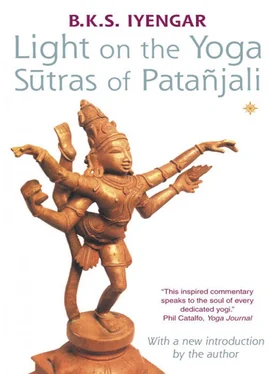1 ...7 8 9 11 12 13 ...20 Avidya , ignorance, or lack of wisdom, is a fertile ground in which afflications can grow, making one’s life a hell. Mistaking the transient for the eternal, the impure for the pure, pain for pleasure, and the pleasures of the world for the bliss of the spirit constitutes avidya.
Identifying the individual ego (the ‘I’) with the real soul is asmita. It is the false identification of the ego with the seer.
Encouraging and gratifying desires is raga. When desires are not gratified, frustration and sorrow give rise to alienation or hate. This is dvesa , aversion.
The desire to live forever and to preserve one’s individual self is abhinivesa. Freedom from such attachment to life is very difficult for even a wise, erudite and scholarly person to achieve. If avidya is the mother of afflictions, abhinivesa is its offspring.
All our past actions exert their influence and mould our present and future lives: as you sow, so shall you reap. This is the law of karma , the universal law of cause and effect. If our actions are good and virtuous, afflictions will be minimized; wrong actions will bring sorrow and pain. Actions may bear fruit immediately, later in life or in lives to come. They determine one’s birth, span of life and the types of experiences to be undergone. When spiritual wisdom dawns, one perceives the tinge of sorrow attached even to pleasure, and from then on shuns both pleasure and pain. However, the fruits of actions continue to entrap ordinary beings.
How to minimize afflictions
Patañjali counsels dispassion towards pleasures and pains and recommends the practice of meditation to attain freedom and beatitude. First he describes in detail the eightfold path of yoga. Following this path helps one to avoid the dormant, hidden sufferings which may surface when physical health, energy and mental poise are disturbed. This suggests that the eightfold path of yoga is suitable for the unhealthy as well as for the healthy, enabling all to develop the power to combat physical and mental diseases.
The prime cause of afflictions is avidya: the failure to understand the conjunction between the seer and the seen: purusa and prakrti. The external world lures the seer towards its pleasures, creating desire. The inevitable non-fulfilment of desires in turn creates pain, which suffocates the inner being. Nature and her beauties are there for enjoyment and pleasure ( bhoga ) and also for freedom and emancipation ( yoga). If we use them indiscriminately, we are bound by the chains of pleasure and pain. A judicious use of them leads to the bliss which is free from pleasure mixed with pain. The twin paths to this goal are practice ( abhyasa ), the path of evolution, of going forward; and detachment or renunciation ( vairagya ), the path of involution, abstaining from the fruits of action and from worldly concerns and engagements.
In samkhya philosophy, the process of evolution and the interaction of spirit and matter, essence and form, are carefully explained.
To follow nature’s evolution from its subtlest concept to its grossest or most dense manifestation, we must start with root nature, mula-prakrti. At this phase of its development, nature is infinite, attributeless and undifferentiated. We may call this phase ‘noumenal’ or alinga (without mark): it can be apprehended only by intuition. It is postulated that the qualities of nature, or gunas, exist in mula-prakrti in perfect equilibrium; one third sattva , one third rajas and one third tamas.
Root nature evolves into the phenomenal stage, called linga (with mark). At this point a disturbance or redistribution takes place in the gunas, giving nature its turbulent characteristic, which is to say that one quality will always predominate over the other two (though never to their entire exclusion; for example, the proportion might be 7/10 tamas , 2/10 rajas , 1/10 sattva , or any other disproportionate rate). The first and most subtle stage of the phenomenal universe is mahat , cosmic intelligence. Mahat is the ‘great principle’, embodying a spontaneous motivating force in nature, without subject or object, acting in both creation and dissolution.
Nature further evolves into the stage called avisesa (universal or non-specific) which can be understood by the intellect but not directly perceived by the senses. To this phase belong the subtle characteristics of the five elements, which may be equated with the infra-atomic structure of elements. These may be explained at a basic level as the inherent quality of smell in earth (prthvi), of taste in water ( ap ), of sight or shape in fire ( tej ), of touch in air ( vayu ) and of sound in ether (akasa). The ‘I’ principle is also in this group.
The final stage, visesa, in which nature is specific and obviously manifest, includes the five elements, the five senses of perception (ears, eyes, nose, tongue and skin), the five organs of action (arms, legs, mouth, generative and excretory organs), and lastly the mind, or the eleventh sense. So in all, there are twenty-four principles ( tattvas ) of nature, and a twenty-fifth: purusa, atman , or soul. Purus permeates and transcends nature, without belonging to it.
(When purusa stirs the other principles into activity, it is the path of evolution. Its withdrawal from nature is the path of involution. If purusa interacts virtuously with the properties of nature, bliss is experienced; for such a purusa, prakrti becomes a heaven. If wrongly experienced, it becomes a hell.
Sometimes, purusa may remain indifferent, yet we know that nature stirs on its own through the mutation of the gunas, but takes a long time to surface. If purusa, gives a helping hand, nature is disciplined to move in the right way, whether on the path of evolution or involution.)
The sixteen principles of the visesa stage, are the five elements, the five senses of perception and five organs of action, and the mind. They are definable and distinguishable. At the avisesa stage, all five tanmatras – smell, taste, sight or shape, touch and sound – and ahamkara, ego, are undistinguishable and indefinable, yet nevertheless entities in themselves. At the material level of creation, tamas is greater than rajas and sattva , whereas at the psycho-sensory level, rajas and sattva together predominate.
The interaction of the gunas with these sixteen principles shapes our destiny according to our actions. Effectively, our experiences in life derive from the gross manifestations of nature, whether painful or pleasurable; that is, whether manifesting as physical affliction or as art. The delusion that this is the only ‘real’ level can lead to bondage, but fortunately the evolutionary or unfolding structure of nature has provided the possibility of involution, which is the return journey to the source. This is achieved by re-absorbing the specific principles into the non-specific, then back into the alinga state, and finally by withdrawing and merging all phenomenal nature back into its noumenal root, the unmanifested mula-prakrti, rather as one might fold up a telescope.
At the moment when the seer confronts his own self, the principles of nature have been drawn up into their own primordial root and remain quietly there without ruffling the serenity of the purusa. It is sufficient to say here that the involutionary process is achieved by the intervention of discriminating intelligence, and by taming and re-balancing the gunas to their noumenal perfect proportions, so that each stage of re-absorption can take place. Yoga shows us how to do this, starting from the most basic manifest level, our own body.
Читать дальше












